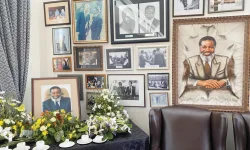The residence of Namibia's first president, Sam Nujoma, reflects his rich heritage, personal principles, and welcoming nature. His brownish house sits between the Avis mountains near Windhoek, surrounded by vibrant greenery thanks to recent rainfall. The Namibian newspaper visited the property Wednesday to explore where the founding leader hosted numerous distinguished guests, including Kenneth Kaunda from Zambia and Jerry Rawlings of Ghana. The residence features separate areas for receiving visitors, family living spaces, and staff quarters.
Lush plants fill the home, especially roses, rumored to be Nujoma's preferred flowers. Swapo flags adorn every building throughout the property. Four tall palm trees stand at the entrance, resembling fingers pointing skyward alongside metal sculptures shaped like musical flutes. A staff member cautions visitors about standing near these structures because lightning strikes frequently happen there. Inside, visitors notice marble floors, high ceilings, detailed lighting fixtures, and soft hymns playing through hidden speakers.
The reception area contains numerous flower arrangements and photographs showing Nujoma with his family wearing traditional Odelela outfits. Among these images appear pictures of two significant women from his life - his mother, Helvi Kondombolo, and his wife, Kovambo. Additional photos display Nujoma during various stages of his political career. Behind the reception area sits a private living room where he entertained important visitors. This space features elaborate chandeliers, shiny furniture, awards, calabashes, and wedding photos from 1956.
More photographs decorate the walls, showing the former president smiling and greeting people. Notable portraits capture him alongside Nelson Mandela, Kenneth Kaunda, Robert Mugabe, and Fidel Castro. The government demolished his original residence in 2015, an old German farmhouse donated by Swapo before independence. John Nauta, former senior special assistant, explains that engineers deemed the structure beyond renovation due to age. The founding president desired a more spacious residence for entertaining guests.
John Rufero, a thirteen-year gardener, describes how Nujoma deeply appreciated landscaping and cultivation. He particularly enjoyed planting and maintaining clean surroundings. Rufero remembers how heartbroken Nujoma became when construction crews destroyed his beautiful garden during the 2015 demolition. They planted fruit trees, including orange, lemon, and mango varieties, along with palm trees and bougainvilleas. According to Rufero, Nujoma preferred trees that produced fruit rather than merely decorative species.
Betty Wilbard, employed by the household for forty-two years, recalls how Nujoma valued family gatherings where he spent time with children and grandchildren around fires. She mentions that both Nujoma and his wife would share stories about their exile experiences during these family meetings. Wilbard emphasizes the residence never served as just the president's personal space but functioned as an open home where he welcomed everyone who visited, regardless of their background or status.
Lush plants fill the home, especially roses, rumored to be Nujoma's preferred flowers. Swapo flags adorn every building throughout the property. Four tall palm trees stand at the entrance, resembling fingers pointing skyward alongside metal sculptures shaped like musical flutes. A staff member cautions visitors about standing near these structures because lightning strikes frequently happen there. Inside, visitors notice marble floors, high ceilings, detailed lighting fixtures, and soft hymns playing through hidden speakers.
The reception area contains numerous flower arrangements and photographs showing Nujoma with his family wearing traditional Odelela outfits. Among these images appear pictures of two significant women from his life - his mother, Helvi Kondombolo, and his wife, Kovambo. Additional photos display Nujoma during various stages of his political career. Behind the reception area sits a private living room where he entertained important visitors. This space features elaborate chandeliers, shiny furniture, awards, calabashes, and wedding photos from 1956.
More photographs decorate the walls, showing the former president smiling and greeting people. Notable portraits capture him alongside Nelson Mandela, Kenneth Kaunda, Robert Mugabe, and Fidel Castro. The government demolished his original residence in 2015, an old German farmhouse donated by Swapo before independence. John Nauta, former senior special assistant, explains that engineers deemed the structure beyond renovation due to age. The founding president desired a more spacious residence for entertaining guests.
John Rufero, a thirteen-year gardener, describes how Nujoma deeply appreciated landscaping and cultivation. He particularly enjoyed planting and maintaining clean surroundings. Rufero remembers how heartbroken Nujoma became when construction crews destroyed his beautiful garden during the 2015 demolition. They planted fruit trees, including orange, lemon, and mango varieties, along with palm trees and bougainvilleas. According to Rufero, Nujoma preferred trees that produced fruit rather than merely decorative species.
Betty Wilbard, employed by the household for forty-two years, recalls how Nujoma valued family gatherings where he spent time with children and grandchildren around fires. She mentions that both Nujoma and his wife would share stories about their exile experiences during these family meetings. Wilbard emphasizes the residence never served as just the president's personal space but functioned as an open home where he welcomed everyone who visited, regardless of their background or status.












